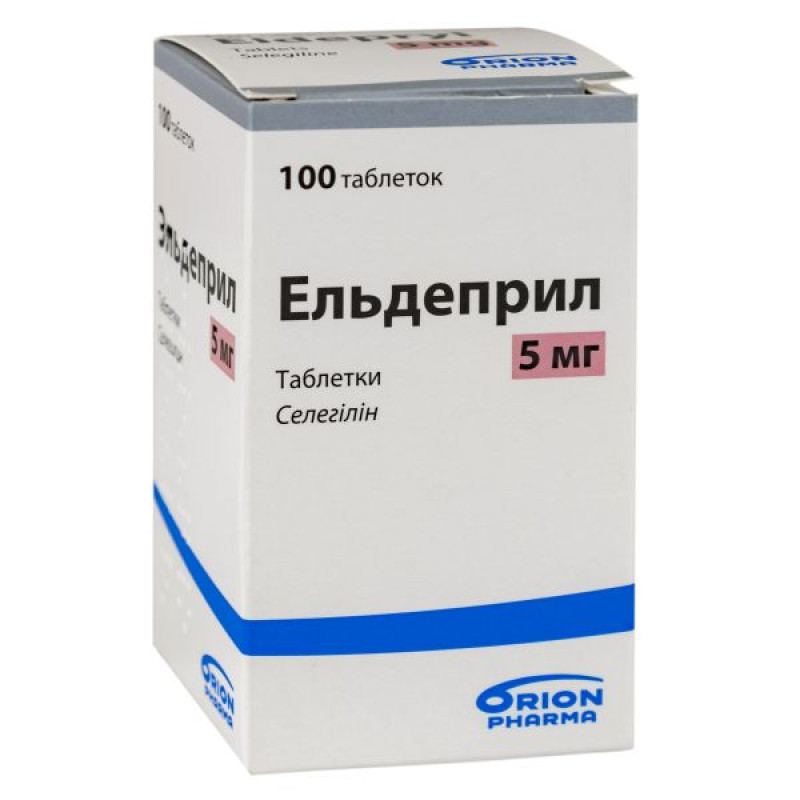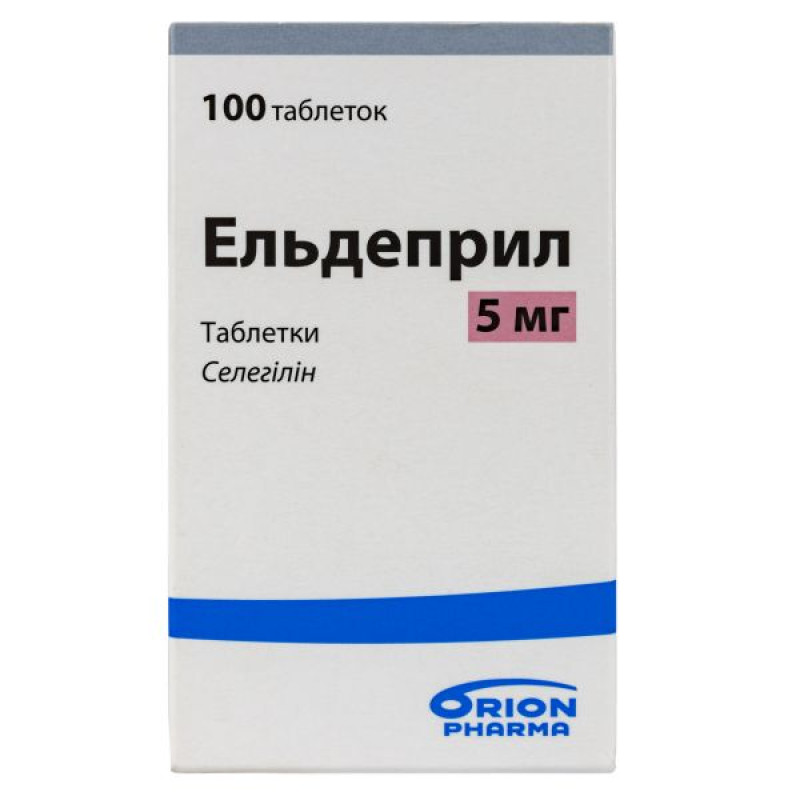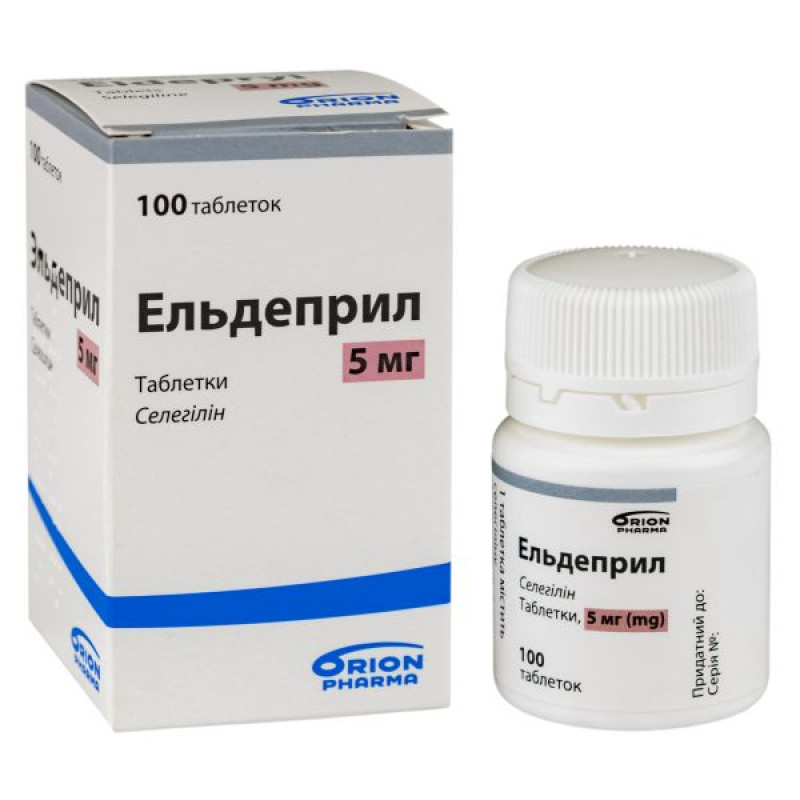Eldepryl tablets 5 mg bottle No. 100

Pharmacological properties
Pharmacodynamics. Selegiline is a selective MAO-B inhibitor that also inhibits dopamine reuptake and the presynaptic dopamine receptor. These effects potentiate dopaminergic function in the brain. Selegiline potentiates and prolongs the effect of levodopa, allowing a lower dose of the latter. In combination with levodopa drugs, selegiline increases the duration of the "on" period, reduces the duration of the "off" period, and reduces the severity of the final dose depletion phenomenon. Selegiline does not potentiate the hypertensive effect of substances such as tyramine (cheese effect).
Pharmacokinetics. Selegiline is rapidly absorbed from the gastrointestinal tract. C max in the blood is reached 30-45 min after oral administration. Bioavailability is low; on average, 10% of unchanged selegiline reaches the systemic circulation (however, there is significant variation between patients). Selegiline is a lipophilic compound with a slightly alkaline reaction, easily penetrates tissues, including the brain. It is rapidly distributed in the body, the volume of distribution is about 500 l after intravenous administration at a dose of 10 mg. When used in therapeutic doses, 75-85% of selegiline binds to plasma proteins. Selegiline is rapidly metabolized (mainly in the liver) to desmethylselegiline, 1-methamphetamine and 1-amphetamine. These three metabolites are detected in plasma and urine after single and multiple doses of selegiline. The average T ½ is 1.5-3.5 hours. The total clearance of selegiline in the body is about 240 l / h. Selegiline metabolites are mainly excreted in the urine, about 15% - in the feces. Due to irreversible inhibition of MAO-B, the duration of the therapeutic effect does not depend on the time of selegiline excretion, so taking the drug once a day is sufficient.
Indication
Parkinson's disease or symptomatic parkinsonism - as monotherapy in the early stage of the disease or in combination with levodopa drugs (in combination with or without peripheral decarboxylase inhibitors).
Application
Selegiline is used as monotherapy in the early stages of the disease or in combination with levodopa (with or without peripheral decarboxylase inhibitors). In both cases, the initial dose is 5 mg, taken in the morning. The dose of eldepryl can be increased to 10 mg/day (can be taken in the morning or divided into two doses).
If, when using the drug as an adjunctive therapy to levodopa drugs, adverse reactions caused by levodopa occur, the dose of the latter should be reduced.
Hepatic impairment: There is no information on dose adjustment in patients with hepatic impairment.
Renal impairment: There is no information on dosage adjustment in patients with renal impairment.
Contraindication
Hypersensitivity to selegiline or any of the excipients.
Gastric and duodenal ulcer in the acute stage.
Concomitant use with serotonin reuptake inhibitors, serotonin and norepinephrine reuptake inhibitors (venlafaxine), tricyclic antidepressants, sympathomimetics, MAO inhibitors (linezolid) or opiate drugs (pethidine) (see Interactions with other drugs).
When combining selegiline with levodopa, contraindications to the use of levodopa should be taken into account.
Side effects
The frequency of adverse reactions is classified as follows: very common (≥1/10); common (≥1/100, 1/10); uncommon (≥1/1000, 1/100); rare (≥1/10,000-1/1000); very rare (1/10,000), frequency unknown (cannot be determined from the available data).
Psychiatric disorders: often - confusion, hallucinations; infrequently - mood swings; frequency unknown - impulse control disorders and compulsions (such as hypersexuality).
Nervous system disorders: often - involuntary movements (dyskinesia), dizziness, headache; infrequently - transient sleep disturbances (insomnia); rarely - agitation.
Cardiac disorders: often - bradycardia; infrequently - supraventricular tachycardia; rarely - arrhythmias.
Vascular disorders: rarely - postural hypotension.
Gastrointestinal disorders: often - nausea; infrequently - dry mouth.
Liver disorders: sometimes - increased levels of liver enzymes.
Skin and subcutaneous tissue disorders: rarely - rash.
Renal and urinary disorders: rarely - difficulty urinating; frequency unknown - urinary retention.
When using the drug, side effects such as psychosis, depression, tremor, pain in the chest, back, joints, throat, vertigo, visual disturbances, vomiting, constipation, diarrhea also occur.
In combination with levodopa. Since the drug enhances the effect of levodopa, the side effects of levodopa (such as anxiety, hyperkinesia, atypical movements, agitation, confusion, hallucinations, postural hypotension, cardiac arrhythmias, dysphonia) may be increased in the case of combination therapy (levodopa should usually be used in combination with a peripheral decarboxylase inhibitor). If side effects caused by levodopa occur when using the drug in combination with levodopa drugs, the dose of the latter should be reduced. Therefore, with the start of treatment with selegiline, the dose of levodopa can be reduced by an average of 30%.
Special instructions
Special caution should be exercised when using selegiline in patients with duodenal ulcer, labile hypertension, cardiac arrhythmia, severe angina, severe hepatic or renal insufficiency, or psychosis.
Since selegiline potentiates the effect of levodopa, the adverse reactions caused by levodopa may be increased, especially when high doses of levodopa are used. Patients receiving such treatment should be carefully monitored. When selegiline is added to levodopa, symptoms such as involuntary movements and/or agitation may occur, which disappear when the dose of levodopa is reduced. Therefore, with the start of treatment with selegiline, the dose of levodopa can be reduced by an average of 30%.
At high doses (greater than 10 mg/day), selegiline's selectivity for MAO-B begins to decrease, leading to increased inhibition of MAO-A. Thus, the risk of hypertension increases.
In patients taking MAO inhibitors, caution should be exercised when administering general anesthesia in surgical practice.
Impulse control disorders and compulsive behaviors, such as pathological gambling, increased libido and hypersexuality, bulimia, spending and other compulsive or repetitive behaviors, have been reported in patients with Parkinson's disease during treatment with dopamine agonists or other dopaminergic drugs, such as selegiline.
Some studies have suggested that patients taking selegiline and levodopa have a higher mortality rate than patients taking levodopa alone. However, it should be noted that these studies have had numerous methodological flaws and that meta-analyses and large cohort studies have concluded that there is no statistically significant difference in mortality between patients taking selegiline and those taking comparators or the combination of selegiline and levodopa.
The combination of selegiline and levodopa is not appropriate in patients with dose-independent changes in response to treatment.
Selegiline should be combined with drugs that act primarily on the central nervous system with caution.
The concomitant use of selegiline with alcohol should be avoided.
Use during pregnancy and breastfeeding. Since there is insufficient data on the safety of selegiline during pregnancy and breastfeeding, selegiline should not be used in this category of patients.
Children. There is no information on the use of the drug in children, therefore the use of the drug in this category of patients is not indicated.
Ability to influence the reaction rate when driving vehicles or operating other mechanisms. The effect of selegiline on the ability to drive a car or operate machinery has not been studied. Dizziness may occur during treatment with selegiline. In such cases, you should refrain from driving vehicles or operating other mechanisms.
Interactions
The following combinations are contraindicated:
Sympathomimetics: Concomitant use of selegiline with sympathomimetics may cause severe hypertension.
Pethidine: Concomitant use of selegiline (a selective MAO inhibitor) and pethidine is contraindicated. Selegiline and pethidine are known to interact with each other with a potentially fatal outcome, but the mechanism of this interaction is not yet understood.
Tramadol may also interact with selegiline.
Selective serotonin reuptake inhibitors and serotonin and norepinephrine reuptake inhibitors (venlafaxine). When combining fluoxetine with selegiline, increased sweating, flushing, ataxia, tremor, hyperthermia, arterial hyper- and hypotension, convulsions, palpitations, dizziness, agitation, confusion, hallucinations, delirium and coma may occur. Since fluoxetine and its active metabolites have a long T ½, at least 5 weeks should elapse between the withdrawal of fluoxetine and the start of selegiline therapy. Selegiline and its metabolites have a short T ½, therefore a 2-week interval is sufficient between the withdrawal of selegiline and the start of fluoxetine.
Tricyclic antidepressants. When combining selegiline with tricyclic antidepressants, toxic effects from the central nervous system (dizziness, tremor, convulsions) may occur; sometimes - arterial hyper- or hypotension, increased sweating. Since the mechanism of these reactions is not sufficiently understood, the simultaneous use of selegiline and tricyclic antidepressants is contraindicated.
MAO inhibitors: Concomitant use of MAO inhibitors with selegiline may cause severe hypotension or hypertension.
Combinations that are not recommended
Oral contraceptives: Caution should be exercised when selegiline is used concomitantly with combined oral contraceptives (gestagen/ethinyl estradiol or levonorgestrel/ethinyl estradiol) as they may increase the bioavailability of selegiline.
Food interactions: Unlike traditional MAO inhibitors, which inhibit both MAO-A and MAO-B, selegiline is a selective inhibitor of MAO-B.
However, when combining selegiline and traditional MAO inhibitors or MAO-A inhibitors, it is recommended to strictly adhere to the diet (avoid foods high in tyramine - mature cheese and products containing yeast).
Overdose
There are no data on clinically significant overdose of the drug. The effect of selegiline as a selective MAO inhibitor is achieved when used in doses recommended for the treatment of Parkinson's disease (5-10 mg/day). Symptoms of overdose may be similar to symptoms of overdose with non-selective MAO inhibitors (such as drowsiness, dizziness, irritability, agitation, hyperactivity, tremor, anxiety, severe muscle spasms, severe headache, hallucinations, angina pectoris, arterial hypotension, chest pain, rapid and uneven pulse, vascular collapse, respiratory failure, respiratory depression, increased sweating, hyperthermia, coma, convulsions). Symptoms of overdose may develop within 24 hours. There is no specific antidote, treatment is symptomatic.
Storage conditions
At room temperature 15-25 °C.
There are no reviews for this product.
There are no reviews for this product, be the first to leave your review.
No questions about this product, be the first and ask your question.










